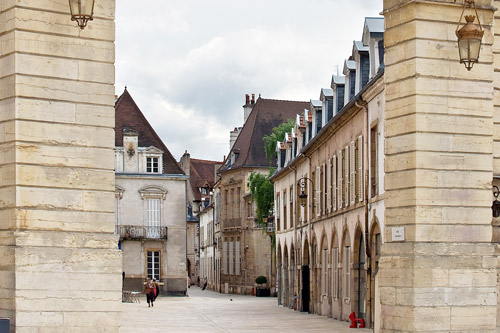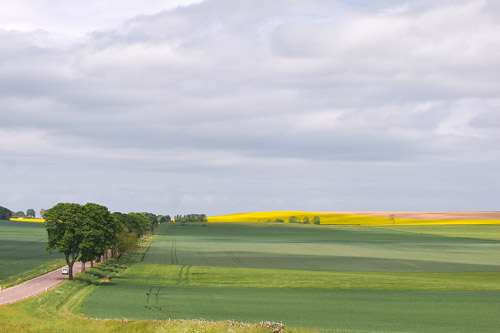What’s In A Name
No sooner did I see the name ‘Dijon’ on our map in the car as we drove to the town from Lyon in May than I could almost taste the delicious, grainy mustard for which the town is so well known.
Having decided to take ‘the slow boat to China’ to travel from Lyon to Dijon in the eastern part of France by opting for the side roads and delightful country sights versus the far quicker autoroute, we passed mile after mile of vineyards as we got closer to Dijon.
Here is a photograph of the center of this town which is the historical capital of the province of Burgundy:

New! Now you can buy a large art print of this image from Quillcards.
The print includes a quotation from Shakespeare on the subject of love.
Under the Spell
A hot spell was gripping the region, and the vineyards gleamed in the baking temperatures along the roads leading to Dijon.
The vineyards were dotted with people here and there who were tending the grapes, and we felt concern about the workers as we watched their bent figures.
The Wines of Burgundy
We read in our guidebooks that this Burgundy region was one of the premiere regions for wines. I don’t know much about wines, but of course I recognized Pinot Noir, Chardonnay, Chablis, and Beaujolais – the names of some of the world-famous wines created in the area.
‘Mellow Yellow’ It Isn’t
As well as seeing vast rows of ripening grapes on sturdy vines, we saw swatches of shocking-yellow rapeseed carpeting the fields as you can see in the photograph below:

One can also see such rapeseed crops in the countryside around our home in England at this time of the year. Whenever I see rapeseed blossoming in England or in France, I have the same reaction, time and again: I gasp at its startling, unbelievable (as in ‘un-believable’) beauty.
Van Gogh’s Genius
I immediately thought of Van Gogh’s paintings when I first caught sight of rapeseed.
When Van Gogh painted such scenes, I had reasoned before I moved to England ten years ago, surely he was exaggerating reality.
Ah, but once I saw the color for myself as it is in nature – then I understood that it was Van Gogh’s genius that enabled him to relay such explosion of color on his canvasses.
Hunting for Mustard
Now that I was traveling in the Burgundy region close to Dijon, I wondered if mustard plants looked as vivid as rapeseed does. Living most of my life in cities and new to learning about nature, I was ignorant as to what we could find.
In fact, we didn’t see anything yellow other than the rapeseed on our travels from Lyon to Dijon, or at least what we could identify.
The Canadian Connection
So when we finally reached Dijon, we visited the Maille mustard store that has been in existence since 1777, and it was natural for us to ask where the fields of mustard plants were in the Dijon outskirts through which we had traveled.
We spoke in French and English to the amiable, friendly store employees.
So imagine our complete surprise when theytold us where the mustard plants grow that Maille uses for its delicious mustard: None other than in Canada!
Canada, you may ask (as indeed we did too)?
About Mustard Crops and Jean Naigeon
I have since found out from various sources that indeed 85% – 90% of the world’s mustard crops are grown in Canada, Montana, and North Dakota.
Most mustard producers purchase seeds from farming cooperatives that maintain huge quantities of seed for the mustard market.
I wonder what Jean Naigeon – credited with the recipe for Dijon Mustard more than two hundred and fifty years ago – would think about such modern ways?